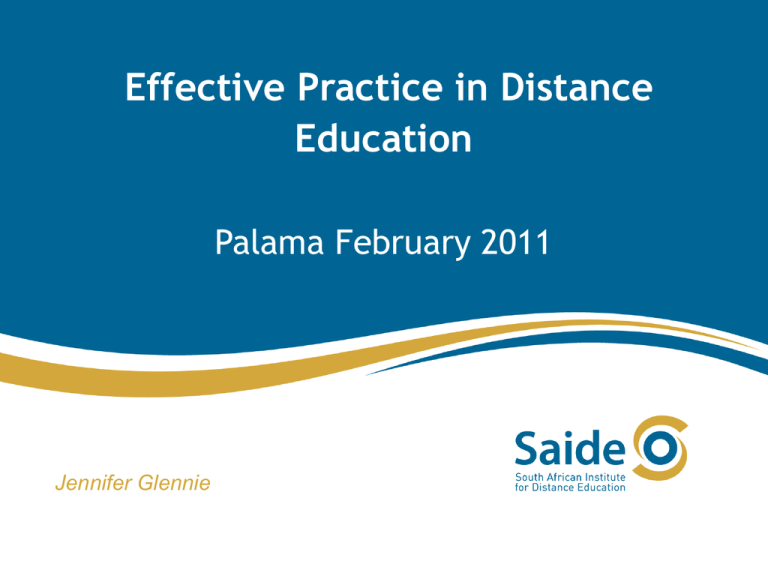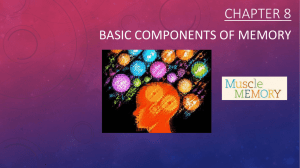Effective Practice in Distance Education
advertisement

Effective Practice in Distance Education Palama February 2011 Jennifer Glennie This Presentation Why use distance education? The relationship between distance education and elearning Approaching the design and implementation of distance education programmes Guidelines for good practice Quality assuring distance education programmes Distance Education in SA Comprises on average 40% of higher education enrolments over the last 10 years Actual/Planned Enrolments 1000000 900000 800000 700000 600000 500000 400000 300000 200000 100000 0 CONTACT ENROLMENT DISTANCE ENROLMENT 2013 2012 2011 2010 2009 2008 2007 2006 2005 2004 2003 2002 2001 2000 TOTAL Distance Education Describes a collection of methods for the provision of structured learning which together avoid the need for learners to discover the curriculum by attending classes frequently at a central venue for long periods. It uses an appropriate combination of different learning resources as well as tutorial support (online or face to face), peer group discussion, and practical sessions. Why Use Distance Education? Of particular relevance to Palama: Can accommodate participants who are unable frequently to attend fixed classes at a centralised venue Can far more easily accommodate large numbers Has the potential to be more cost-effective Continuum of Educational Provision From purely face to face (contact) tuition through to education purely at a distance Introducing the WWW In any educational setting – distance or face to face -, the World Wide Web (WWW) can be used to a lesser or greater extent Extending to e-Learning Includes all online educational activity, but it can also include offline digital resources E.g. an offline course may be supported digitally by the use of CDs or other resources stored on a computer Are Distance Education and eLearning the Same? We conceptualise the two continua in relation to each other as horizontal and vertical axes. Situating various courses or programmes on this grid illustrates the degree to which each mode of delivery involves face-to-face contact, while simultaneously exploring the type of elearning (if any) that is involved. D Fully Online E Web Dependent Web Supported B Digitally Supported A C No digital support Face to Face Mixed Mode Distance Ed Approaching the Design and Delivery of Distance Education Students will engage in more independent study Educators can’t rely on regular conversations with their students The system can’t rely on the educator giving frequent instructions to the students Approaching the Design and Delivery of Distance Education Requires the ability to anticipate what the student will do, think or say when engaged in a learning process Requires that the many assumptions that are made are tested Requires far more upfront planning and preparation Requires a range of well-functioning systems – the WWW makes this provision much easier Developing a course Requirements of the job National policies Target qualifications and accreditation Contextual research Target audience: needs and profiles Learning environment Approach to teaching and learning Key purpose and outcomes Content and skills emphases Teaching and learning methods Independent study Course materials Assessment strategy Formative and summative Feedback to students Recording and reporting , Staff or external agencies Technologies Internal monitoring/moderation External moderation, © SAIDE 2003 Group activities Work-based activities Individual support & tutoring Models vs Guidelines of Good Practice If distance education is a ‘collection of methods’ to …., then it makes more sense to develop guidelines of good practice NADEOSA has done just that – adapted by the Asian Open Universities and many others Guidelines cover the most important dimensions of distance education NADEOSA Quality Guidelines Policy and planning Learners Programme development Course design Course materials Assessment Learner support HRD Management and administration Collaborative arrangements Quality assurance Information dissemination Results Alignment to HEQC Although differently structured, NADEOSA criteria can easily map onto HEQC programme accreditation criteria An Example: Learners Criterion There is up-to-date detailed information about past, present and potential learners. This is used to inform policy and planning in programme development, course design and materials development, learner support and other relevant aspects of educational provision Learners Examples of elements of the criterion: The provider has developed a learner profile…. Research into learners is a high priority and is used to inform all aspects of policy The MIS provides for tracking of learner performance… Tutors have access to learner information… .. Implications of Learner Profile Profile Implications Computer access and literacy Likely that most students will have online computers on their desks. They will have first level skills in Word but not skills in Excel Have to teach concepts – need learning guides, not simply textbooks. Textbooks present concepts, but learning guides should teach them. 1. Course design for distance education should provide support in management of own learning Conceptual and theoretical grasp of this area not strong Difficulties with managing own learning in a second language 2. Language and learning support should be built into the materials. 3. Academic literacy issues to be tackled in first DE year xxxxxx xxxxxxx Another Example: Course Design Criterion The course curriculum is well-researched, with aims and learning outcomes appropriate to the level of study; content, teaching and learning methods and assessment facilitate the achievement of stated aims and outcomes; there is an identified process for the development and evaluation of courses Purpose, Learning Tasks & Assessment Programme Exit level outcomes Module learning outcomes Including Foundational Practical & Reflexive Competences How do I know they can do this? Module assessment criteria Module key learning tasks Module key assessment tasks How do I know they can do this? How do I know they can do this? How do I know they can do this? Course Design and Development Course materials Assessment Learning support Common South African Concerns in Distance Education Numbers of learners enrolled exceed the capacity of the staff and infrastructure to provide for learner support and appropriate assessment There are not proper arrangements for recruitment, training, monitoring, and payment of the necessary parttime staff Assessment is not recognised as a integral part of the t&l process and a key motivator of learning Quality Assuring Distance Education Those policies, systems, strategies and resources used by the institution to satisfy itself that its quality requirements are stipulated to support and sustain existing levels of quality to develop and enhance quality to monitor, evaluate and act on resulting recommendations Examples of Processes to Assure Quality Course design and materials development Approving course design Testing materials developmentally Critically reviewing materials Language and copy editing Matching learning tasks and assignments to course purpose Matching summative assessment to purpose Examples of Processes to Assure Quality Learner Support Evaluating tutor recruitment and training processes Monitoring tutor performance Systems to track learner performance Auditing systems periodically In Conclusion If Palama develops excellent learning materials, it could do a service to the nation and the continent to make them available as Open education resources(OER)







